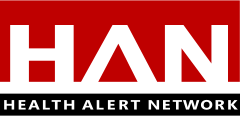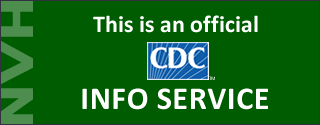HAN 366: CDC Ebola Update #2
Distributed via the CDC Health Alert Network
August 21, 2014, 15:30 ET (3:30 PM ET)
HANINFO-0366
Summary
The Centers for Disease Control and Prevention (CDC) is working with other U.S. government agencies, the World Health Organization, and other domestic and international partners in an international response to the current Ebola outbreak in West Africa. This document summarizes key messages about the outbreak and the response. It will be updated as new information becomes available and distributed regularly. Please share the document with others as appropriate.
Background
CDC has activated its Emergency Operations Center to respond to Ebola. Below, please find resources and guidance that we hope will be useful to you and your organization. Please share with your colleagues and networks.
In this HAN INFOService Message
- Ebola Cases and Deaths (West Africa)
- Online Resources
- Key Messages Summary
Ebola Cases and Deaths (West Africa)
Updated: August 16, 2014
- Suspected and Confirmed Case Count: 2240
- Suspected Case Deaths: 1229
- Laboratory Confirmed Cases: 1383
Updates on cases and deaths can be found on the CDC website:
https://www.cdc.gov/vhf/ebola/outbreaks/guinea/index.html
Online Resources
Web Resources
What’s New
Ebola Hemorrhagic Fever
Spanish Version of Ebola Hemorrhagic Fever Website (NEW)
Questions and Answers on Ebola
World Health Organization’s Epidemic and Pandemic Alert and Response (EPR)
Sequence for Putting On and Removing Personal Protective Equipment (PPE) (NEW)
Guidance on Air Medical Transport for Patients with Ebola Virus Disease (NEW)
Ebola Radio Health Messages in Local Languages
Infographics & Illustrations (English and Spanish)
Outbreak Map
Content Syndication
Put CDC content on Ebola on your website that will update automatically.
Social Media Resources
@CDCgov
@CDCEmergency
@CDCTravel
@CDC_NCEZID
@CDC_eHealth
@CDCGlobal
Like us on Facebook
CDC
CDC Emergency Preparedness and Response
CDC Travelers’ Health
Summary Key Messages
- This is the largest Ebola outbreak in history and the first in West Africa.
- The outbreak in West Africa is worsening, but CDC, along with other U.S. government agencies and international partners, is taking steps to respond to this rapidly changing situation.
- Ebola poses no substantial risk to the U.S. general population.
- On August 8, the World Health Organization (WHO) declared that the current Ebola outbreak is a Public Health Emergency of International Concern (PHEIC).
- The PHEIC declaration underscores the need for a coordinated international response to contain the spread of Ebola.
- Information about the PHEIC declaration is available on the WHO website www.who.int/mediacentre/news/statements/2014/ebola-20140808/en/#.
- A person infected with Ebola virus is not contagious until symptoms appear.
- The virus is spread through direct contact (through broken skin or mucous membranes) with the body fluids (blood, urine, feces, saliva, and other secretions) of a person who is sick with Ebola, or with objects like needles that have been contaminated with the virus, or infected animals.
- Ebola is not spread through the air or by water or, in general, by food; however, in Africa, Ebola may be spread as a result of hunting, processing, and consumption of infected animals (e.g., bushmeat).
- As of August 19, no confirmed Ebola cases have been reported in the United States.
- In 2014, two U.S. healthcare workers who were infected with Ebola virus in Liberia were transported to a hospital in the United States.
- Other persons under investigation in the United States have all tested negative for Ebola.
- As a precaution, CDC is communicating with American healthcare workers about how to detect and isolate patients who may have Ebola and how they can protect themselves from infection.
- Early recognition of Ebola is important for providing appropriate patient care and preventing the spread of infection. Healthcare providers should be alert for and evaluate any patients suspected of having Ebola.
- A case definition for Ebola virus disease is available at www.cdc.gov/vhf/ebola/hcp/case-definition.html.
- CDC and its partners at U.S. ports of entry are not doing enhanced screening of passengers traveling from the affected countries. However, CDC works with international public health organizations, other federal agencies, and the travel industry to identify sick travelers arriving in the United States and take public health actions to prevent the spread of communicable diseases.
- CDC also is assisting with exit screening and communication efforts in West Africa to prevent sick travelers from getting on planes.
- CDC recommends that people avoid nonessential travel to Guinea, Liberia, and Sierra Leone.
- CDC recommends that people practice enhanced precautions if traveling to Nigeria.
- Recommendations and guidance may change as new information becomes available.
NEW Stigma Key Messages
West Africans in the United States and elsewhere may face stigmatization (stigma) during the current Ebola outbreak because the outbreak is associated with a region of the world.
- Stigma involves stereotyping and discriminating against an identifiable group of people, a product, an animal, a place, or a nation.
- Stigma can occur when people associate an infectious disease, such as Ebola, with a population, even though not everyone in that population or from that region is specifically at risk for the disease (for example, West Africans living in the United States).
- Stigma occurred among Asian Americans in the United States during the SARS pandemic in 2003.
- Communicators and public health officials can help counter stigma during the Ebola response.
- Communicate early the risk or lack of risk from associations with products, people, and places.
- Raise awareness of the potential problem.
- Counter stigmatization with accurate risk information about how the virus spreads.
- Speak out against negative behaviors.
- Be cautious about the images that are shared. Make sure they do not reinforce stereotypes.
- Model good behaviors; engage with stigmatized groups in person and through social media.
The Centers for Disease Control and Prevention (CDC) protects people’s health and safety by preventing and controlling diseases and injuries; enhances health decisions by providing credible information on critical health issues; and promotes healthy living through strong partnerships with local, national and international organizations.
Department of Health and Human Services
HAN Message Types
- Health Alert: Conveys the highest level of importance about a public health incident.
- Health Advisory: Provides important information about a public health incident.
- Health Update: Provides updated information about a public health incident.
###
This message was distributed to state and local health officers, state and local epidemiologists, state and local laboratory directors, public information officers, HAN coordinators, and clinician organizations.
###

